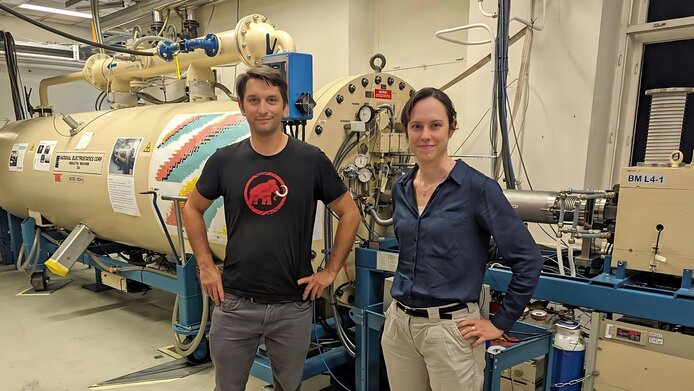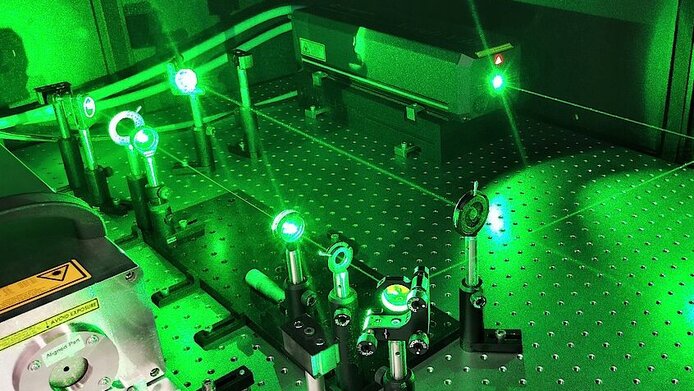Neptunium spikes for environmental research

While we are constantly surrounded by radioactive elements, they generally occur in such small quantities that they present no threat to us. Measuring them precisely can even help researchers to understand the pathways of water in the environment. In a research project funded by the Austrian Science Fund FWF, Karin Hain and her team at the University of Vienna are collaborating with colleagues in Japan to develop new methods to detect these radioactive clues – the element neptunium in particular – in the environment.
In addition to natural sources, there are also anthropogenic or man-made sources of radioactive elements. The best known among these are probably the nuclear disasters at Chernobyl and Fukushima. From a global perspective, however, nuclear weapons tests in the 1950s and 1960s and reprocessing plants for nuclear fuel rods continue to dominate the spread of man-made radioactive elements on Earth.
“We can use these radioactive elements as environmental tracers to identify their pathways in ocean or groundwater currents,” explains Hain. “If we know the exact amount and composition of the radioactive material in a water sample, we can determine where it comes from and it helps us to understand its pathway in water currents.” That is to say, once the researchers know, where the radioactive tracers come from, they could understand the pathways taken by water in the sea or underground, which constitutes an important aspect in environmental research.
This is more easily said than done, given that the quantities of these environmental tracers are in the range of less than one quadrillionth of the sample material, thereby requiring sophisticated measuring equipment such as the Vienna Environmental Research Accelerator (VERA), which is able to detect even the most minuscule of traces.
Neptunium is a candidate
In their research project, Hain and her team are particularly interested in the radioactive element neptunium. “With an estimated 1.5 tons distributed all over the world, neptunium 237 is one of the most common elements in the environment that is heavier than uranium, which means it has been produced artificially,” says Hain. “It has a very long half-life of over two million years and as far as we know today it is also water-soluble in compounds. This makes it a highly interesting environmental tracer.” However, until now an important part of the analytical method was missing for the researchers to be at all able to use the neptunium which is already present in the environment as a tracer.
In principle, the researchers’ measuring equipment can only detect that neptunium is present in a sample, but not exactly how much. But in order to use it as an environmental tracer, it is vital to know the exact amount of neptunium. In order to identify the amount, they need a spike for neptunium 237. A spike is a precisely known quantity of an isotope of neptunium that is added to the sample material during analysis. Isotopes are different variants of an element with different numbers of neutrons but the same number of protons in the atom’s nucleus.
With the FWF-funded project “Production of a spike for the determination of 237Np” (2020-2024) physicist Karin Hain aims to improve methods for detecting radioactive environmental tracers. Her work can also be useful to researchers in the field of ecology.
In this way, the measuring devices can determine the ratio of the quantities of neptunium 237 and the spike material. Since the amount of spike material is known, the actual amount of neptunium 237 in the sample can be determined by back-calculation. If the ratio of neptunium 237 to spike material is two to one, for instance, the sample contains double the amount of neptunium 237 than of spike material.
Hain explains: “Our goal is to use the neptunium 236 isotope to produce a spike for neptunium 237.” For this purpose, she and her team in Vienna collaborated with colleagues at the University of Tsukuba in Japan under the direction of Aya Sakaguchi.
Spikes from the accelerator
With the help of a particle accelerator, the team in Japan shot light lithium atoms at thorium atoms in order to fuse them into the target isotope neptunium 236. However, this produces various unwanted by-products with identical masses, or other neptunium isotopes. “As part of this experiment, our colleagues also had to develop new radiochemical procedures in order to analyze the results and separate the neptunium 236 from the other reaction products as cleanly as possible,” adds Hain.
Using the Vienna Environmental Research Accelerator at the University of Vienna, Hain and her team further investigated the material from Japan by means of a globally unique combination of measurement methods: ion laser interaction mass spectrometry together with an accelerator mass spectrometer. Even though their results are an important step in basic nuclear research, Hain has not lost sight of her original goal of producing enough neptunium 236 for use as a spike.
“The problem is that the accelerator facility in Japan cannot provide the quantities of neptunium 236 that international environmental research would require as spike material,” says Hain. The experiment in Japan showed that neptunium 236 could be produced by irradiation, but a dedicated production facility would be needed to use it widely as a spike. “Perhaps we can collaborate with the International Atomic Energy Agency on this in the future,” Hain ponders. She is looking forward to continuing work on this project: “The great thing about this project is that it brings together basic research in nuclear physics with applied environmental physics.”
Personal details
Karin Hain was interested in nuclear astrophysics early in her life. She studied Engineering Physics at the Munich University of Technology, where she specialized in nuclear and reactor physics. In her master's thesis, she dealt with trace analysis in connection with nuclear waste disposal. During her doctorate in Munich, she learned about the Vienna Environmental Research Accelerator (VERA) and moved to Vienna for a postdoc position. As of 2022, Hain has been an assistant professor at the University of Vienna.
Publication
Hain K., Martschini M., Gülce F. et al: Developing Accelerator Mass Spectrometry Capabilities for Anthropogenic Radionuclide Analysis to Extend the Set of Oceanographic Tracers, in: Frontiers in Marine Science 2022






